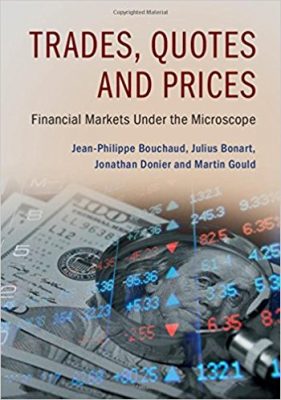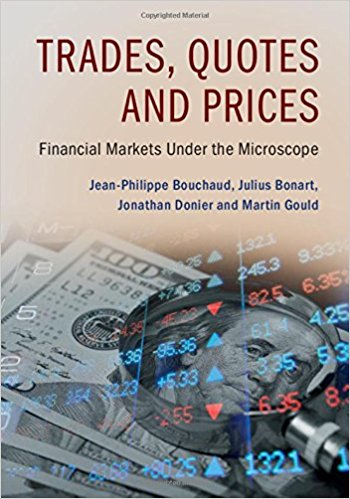 Authors: Jean-Philippe Bouchaud, Julius Bonart, Jonathan Donier, and Martin Gould
Authors: Jean-Philippe Bouchaud, Julius Bonart, Jonathan Donier, and Martin Gould
Publisher: Cambridge University Press – 444 pages
Book Review by: Sonu Chandiram
You likely have not heard of the term ‘econophysics’ even if you are an economist. And most likely, you are not familiar with this word if you are a stock trader. If you do buy and sell stocks, or if you are in one way or another involved in mathematics, you will find this book interesting, unusual, and perhaps even useful.
How can you benefit? While it is difficult to predict price movements to help you decide what price to pay for a certain stock at a given time, other data such as the following can help you achieve some measure of success at buying shares at the right price, and selling them at a profit based on properties in available data such as liquidity and volatility
Other benefits of reading this book are:
- Acquiring a proper understanding of stock market system rules
- Discovering what motivates agents to play the game to begin with
- Knowing who is playing the game, and what challenges they face
- Learning how modern markets operate
- Mastering the nature of the players’ actions and interactions
- Understanding how all of this affects liquidity and volatility
Humans are complex beings, and it is difficult to predict their behaviors in stock buying and selling, and more so because there are hundreds of factors that influence them. Many of those who buy stocks hold them for the long term, and some, like Warren Buffett, hold them “forever”. He has often said that his favorite holding time is forever.
We do not know offhand what percent of those who buy and sell stocks are traders and what percent are investors. Perhaps there are statistics out there about this, and the levels of success achieved (rates of return) based on the various holding periods.
Among stock traders, there are those engaged in day trading. Among investors, there are short- and long-term investors who wait months, years, even decades, to receive their rewards with price appreciation, and with dividends if they have bought shares of companies that pay out dividends annually, quarterly or even monthly.
There are several types of investors. Some are described as ‘value investors’ who look for low price-to-earnings multiples, seldom to exceed PEs of 20. Others are ‘growth investors’ that focus on companies with rapid rates of profit growth. Some investors want both value and growth, such as Buffett. He once remarked that “value and growth are tied at the hip.”
Stock traders have a different approach to making money and spend more time looking at share price movements. While it is difficult to predict the behavior of a single individual stock investor or trader (or a combination thereof) it is easier to see a pattern of stock buying and selling that involves hundreds or thousands of such people. Sometimes these patterns are quite regular in expected outcomes. The authors write in their Introduction:
“Although the actions of a single person may be difficult to predict, the beauty of statistics is that large-scale systems populated by many different people often exhibit robust regularities that transcend individual behaviors. This property appears in countless manifestations in financial markets.”
“An important first example is the way in which different agents (and their models) interpret ‘information’ – whatever that might be. Predicting the direction of price changes has always proven to be difficult, but one might still be able to grasp some fundamental understanding of other market properties, such as volatility or liquidity, due to the strong regularities that emerge from the diverse actions and reactions of the ensemble.”
Since this is the first book I have come across that describes relationships between finance and physics-statistics, I decided to provide you an extensive overview by listing the titles of all its chapters below. You can go straight to any topic you want to find out more about:
- Part I. How and Why Do Prices Move?
- The Ecology of Financial Markets
- The Statistics of Price Changes: An Informal Primer
- Part II. Limit-Order Books: Introduction
- Limit-Order Books
- Empirical Properties of Limit-Order Books
- Part III. Limit-Order Books: Models
- Single-Queue Dynamics: Simple Models
- Single-Queue Dynamics for Large-Tick Stocks
- Joint-Queue Dynamics for Large-Tick Stocks
- The Santa Fe Model for Limit-Order Books
- Part IV. Clustering and Correlations
- Time Clustering and Hawkes Processes
- Long-Range Persistence of Order Flow
- Part V. Price Impact
- The Impact of Market Orders
- The Impact of Metaorders
- Part VI. Market Dynamics at the Micro Scale
- The Propagator Model
- Generalized Propagator Models
- Part VII. Adverse Selection and Liquidity Provision
- The Kyle Model
- The Determinants of the Bid-Ask Spread
- The Profitability of Market Making
- Part VIII. Market Dynamics at the Meso Scale
- Latent Liquidity and Walrasian Auctions
- Impact Dynamics in a Continuous-Time Double Auction
- The Information Content of Prices
- Part IX. Practical Consequences
- Optimal Execution
- Market Fairness and Stability
This book is described by Robert Almgren of New York University and Quantitative Brokers as “a masterful overview of the modern and rapidly developing field of market microstructure from several of its creators. The emphasis is on simple models to explain real and important features of markets, rather than on sophisticated mathematics for its own sake. The style is narrative and illustrative, with extensive reference to more detailed work. A unique feature of the book is its focus on high-frequency data to support the models presented. This book will be an essential resource for practitioners, academics, and regulators alike.”
Doug Farmer of the University of Oxford was so enthused about this book that he describes it in these glowing terms:
“This book describes the dynamics of supply and demand in modern financial markets. It is a beautiful story, full of striking empirical regularities and elegant mathematics, illustrating how the tools of statistical physics can be used to explain financial exchange. This is a tour de force with the square root law of market impact as its climax…”
In summary, I say that this book can provide you guidance and practice lessons on how to be a better trader. But if you want to be a successful investor, the common sense answer is to learn and emulate the habits of the most successful stock investors.
Authors:
Jean-Philippe Bouchaud is a pioneer in econophysics. He cofounded the company Science and Finance in 1994, which merged with Capital Fund Management (CFM) in 2000. He was awarded the CNRS Silver Medal in 1995and the Risk Quant of the Year Award in 2017.
Julius Bonart is a lecturer at University College London, where his research focuses on market microstructure and market design.
Jonathan Donier completed a PhD at University Paris 6 with the support of the Capital Fund Management Research Foundation and currently works in the technology sector.
Martin Gould currently works in the technology sector. Previously he was a James S. McDonnell Postdoctoral Fellow in the CFM Imperial Institute of Quantitative Finance at Imperial College London.







